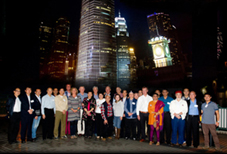|
BACK
in the 1960s, talk was of revolution. The
Chinese Cultural Revolution, the fashion
revolution from London's Carnaby Street
while the streets of San Fransciso, Paris
and Prague seethed with riot and revolutionary
fervor.
Unnoticed
by these all but forgotten revolutionaries
was another revolution taking place in their
midst - the Container Revolution. More than
a passing fashion, or a fashionable political
enthusiasm, this revolution would change
life as we know it by making things possible
that had not been possible before
This
was "Box that Changed the World"
as one book title put it. And last week
40 veterans of the company that started
it all, Sea-Land, gathered at Hong Kong's
Maritime Museum celebrate their lives and
its achievements.
 click image
to enlarge click image
to enlarge
Byron
Lee, now managing director CGL Flying Fish
Logistics (Shanghai), hoped their story
would inspire the young to innovate and
seize opportunities as they themselves had
done decades ago.
Dick
McGregor, now retired to Charlotte, North
Carolina, but active on the board of leapfrogpos.com
"point of sale solutions on demand",
rose to become Sea-Land's head of global
sales.
The
way the old hands talk, it seems that the
full glory days began to fade when the CSX
railway took over the company in 1986, while
others say the trouble began when RJ Reynolds
took over before that.
It
was then that the new bosses "weren't
listening to the music" as World-Link
consultancy chief Alan Goldstein put it,
by which he meant the local ways of doing
things instead of depending on top down
command practices.
"And
when that didn't work, they replaced locals
with their friends and that didn't work
either. Things went down hill from there,"
he said.
Mr
McGregor put it to the CSX takeover in 1986,
saying the railway and the shipping company,
were not a good fit. When someone suggested
the "rhythms were different",
he accepted it readily.
"At
some point Wall Street said you have masses
of assets, railway equipment and ships,
but you should be getting more out if it,"
he said.
The
Maersk takeover was a better fit, but Sea-Land
was a shadow of its former self, no longer
the global powerhouse it had been.
But
more inspiring to the youth of today, and
in keeping with Dr Lee's prescription to
inspire the young, it is fair to say that
all the fun of was in getting there - to
that point when things went south.
It
all started with an innovative North Carolina
trucker called Malcom (no second "L",
please) McLean who wanted to beat regulatory
obstacles in having different truckload
weights for different states, which prevented
efficient cross country movement.
Using
a 35-foot truck trailer length he beat the
system by having truck trailers put into
seven ships going from New Jersey to Texas
in 1955 after buying the incongruously named
Pan-Atlantic Steamship Company.
His
vessels were versions of World War II Liberty
Ships with 40-man crews, weighing in at
6,000 deadweight tons compared to the 157,000
tons of a big containership with its 20-man
crew today. These first containerships would
have been 500-TEUers without the wasted
empty cube provided by the trailer chassis
themselves.
They
were soon using C2s and converted tankers,
recalled Brian Fitzgibbon, who was a ship's
master on the Pacific, who started with
Swire from his native Australia. Now retired,
Capt Fitzgibbon was recalled to handle the
Maersk Line Limited's situation room when
the Maersk Alabama was captured by pirates
in 2009 and went to Mombasa to get the ship
back in service.
Sea-Land's
big break was what launched the next phase
of the worldwide container revolution. It
came in the Vietnam War when the Pentagon
took note of the McLean's efficiencies.
The
Pentagon paid handsomely for the voyage
there and back. Ships were loaded with war
materiel going, but returned mostly empty
- but not for long.
Old
Sea-Land hands fell to quarrelling about
what happened next, whether it was Hong
Kong, Yokohama or Busan, that started the
next phase of the container revolution,
but they agreed that whichever port it was,
the others soon followed.
The
result was Sea-Land was getting paid three
times for a two-way trip. And this so upset
the Japanese, who saw all their hot cargo,
cameras, photocopiers, cars and car parts,
were all going out in American ships in
these secure newfangled containers that
they plunged into shipbuilding and shipping
boom of their own.
And
the game was afoot. By now others had plugged
in, Atlantic Container Line, Furness Withy-Manchester
Liners and Canadian Pacific Steamships were
going from New York, Quebec City and Montreal
to UK-North Continent. Again the ships deployed,
even the new cellular ones, were little
more than jumped up World War II Liberty
ships of 500 TEU.
Little
did those pioneers partying at the Maritime
Museum appreciate what they had set in motion
- a train of events that has led to such
economies of scale that changed the way
we lived worldwide.
Back
in the mid-'70 even middle class Europeans
and Americans - the only affluent markets
- bought poor quality domestic goods, often
with built-in obsolescence, yet shielded
from competition by tariffs and non-tariff
barriers. People only bought fruit in season
and locally made television sets and microwave
ovens which was the highest level of consumer
electronics at the time when clunky computers
were making their debut in offices.
Only
the rich bought imported goods in any volume
or regularity, Gucci shoes from Italy, Scotch
whisky from Scotland and truffles from France.
With
goodies like that crossing the docks, and
breakbulk cargo handling, pilferage was
huge and often out-of-control. It was hard
to police and nearly impossible to prosecute.
A
typical problem started when an importer
found 10 Nikon cameras missing from his
20-box consignment when it arrived in Toronto.
Page 1 2
[Next]
|